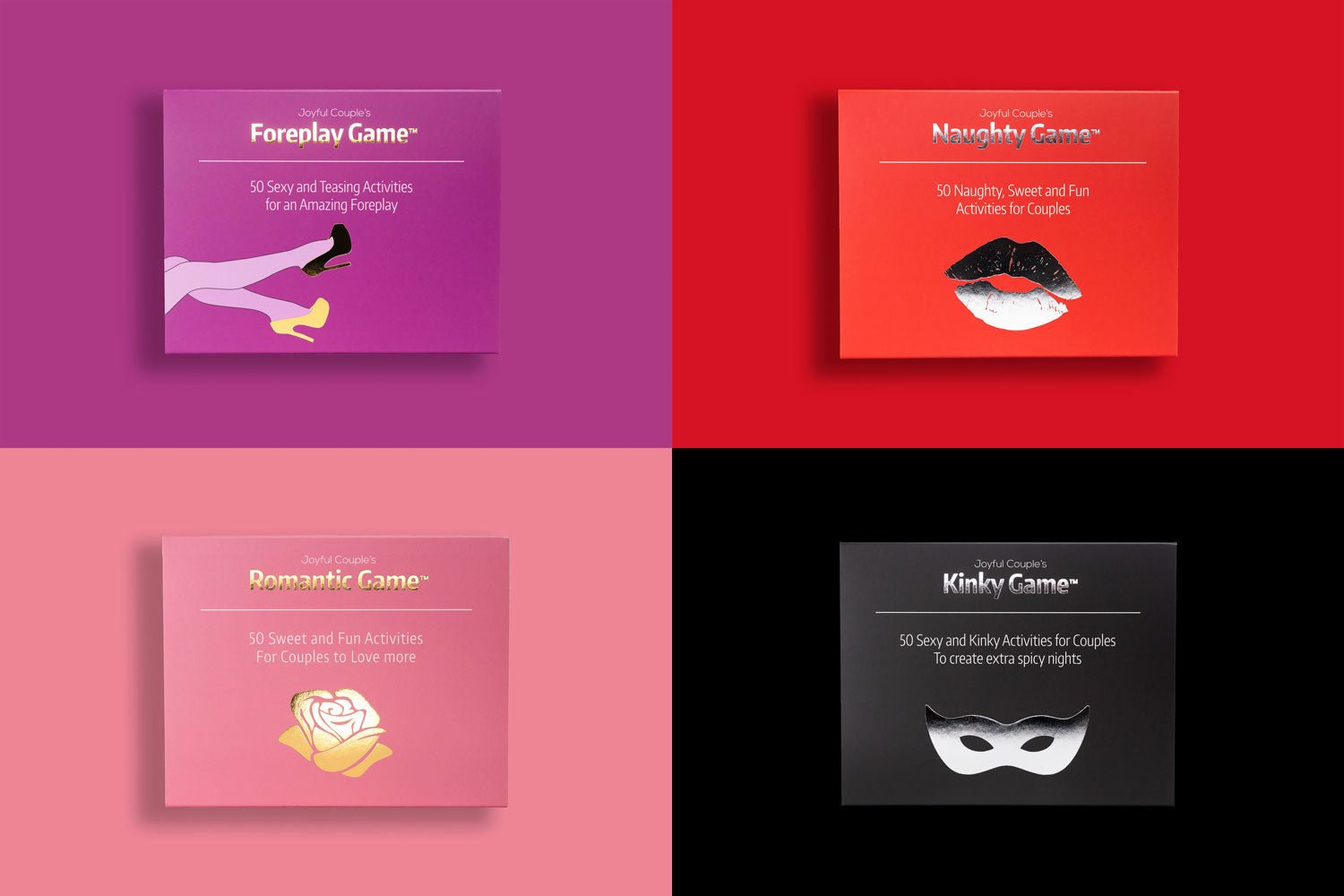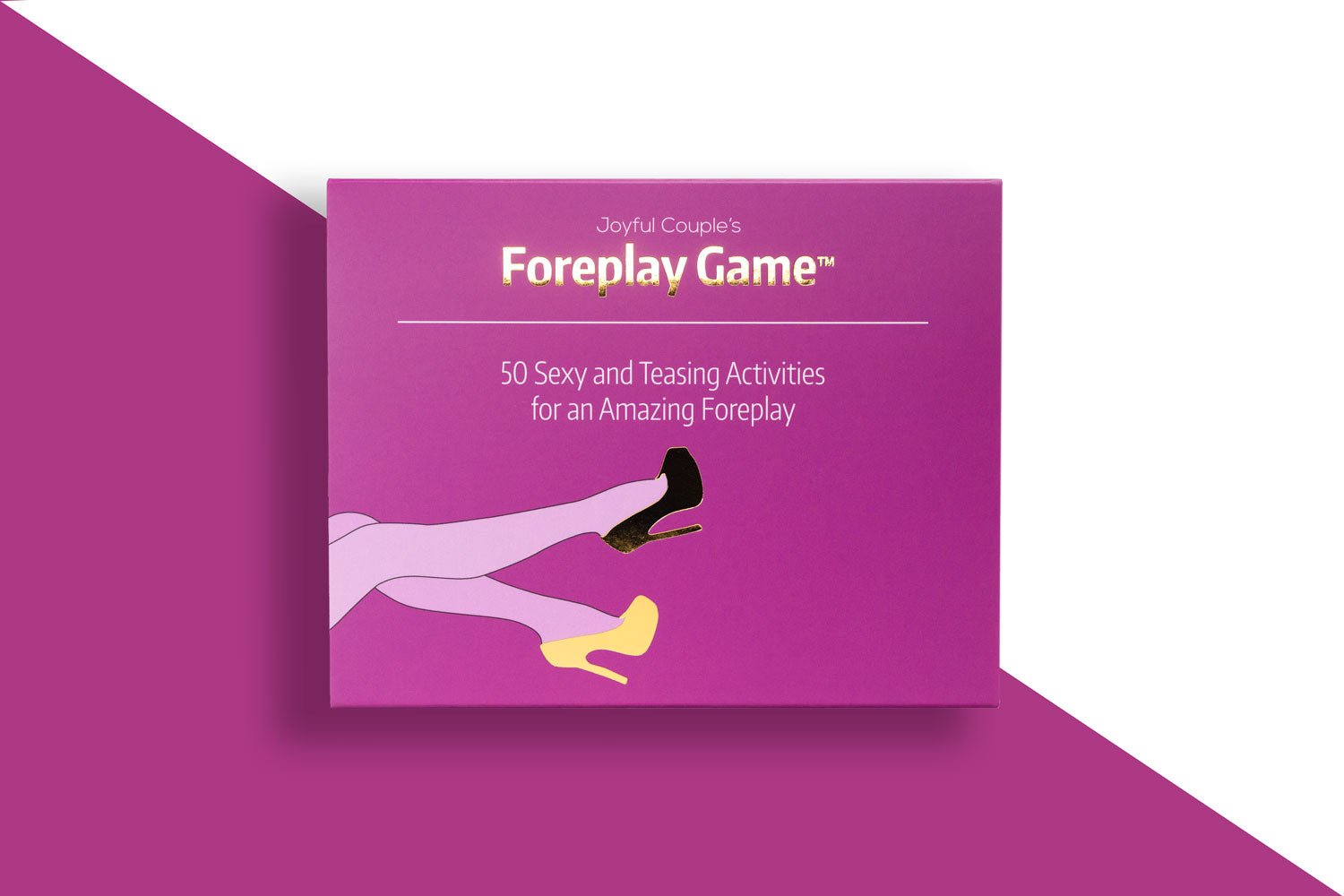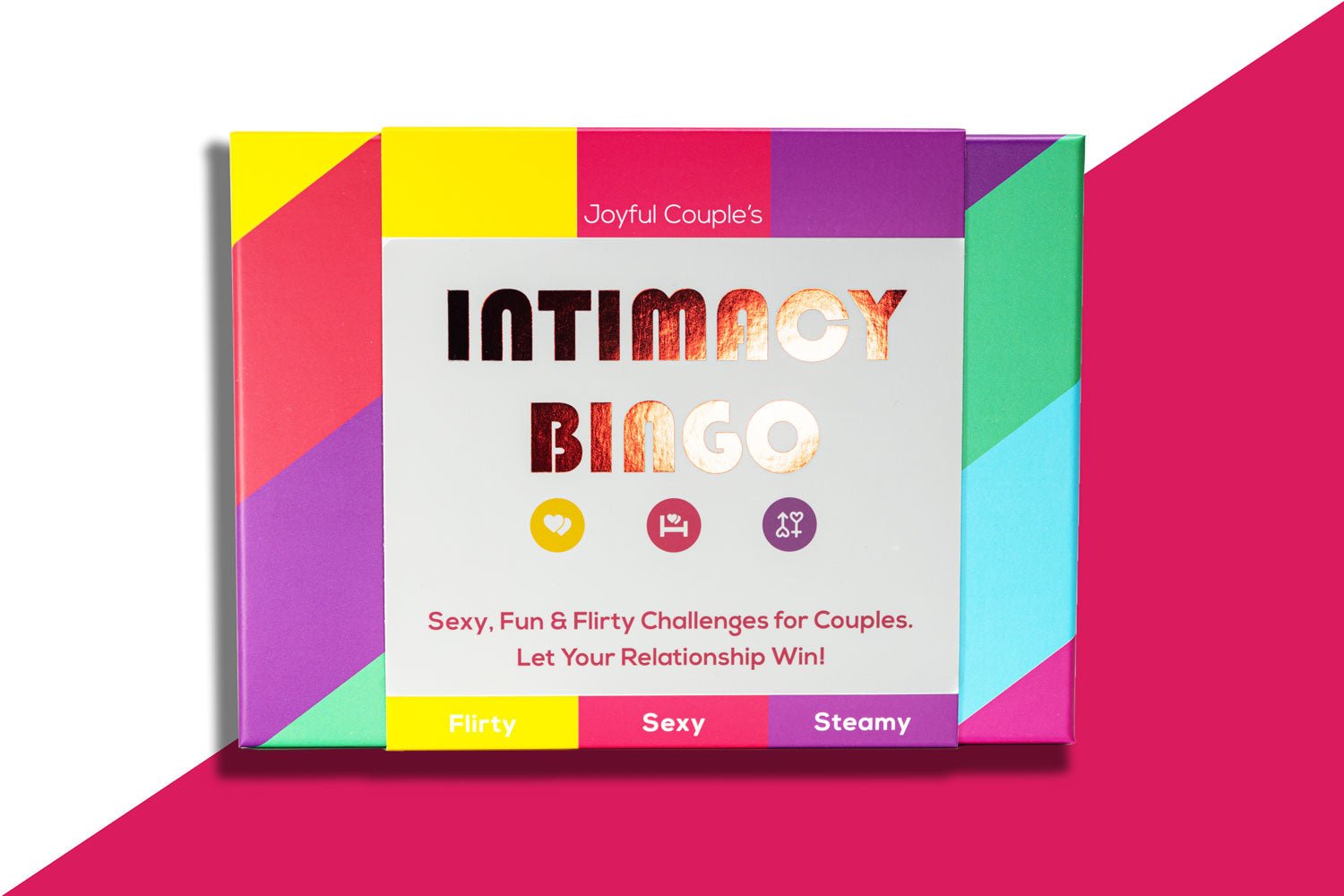Updated: May 29th, 2025
In the world of intimacy and exploration, consent and boundaries in intimacy are the foundation of trust. Whether you're new to BDSM communication techniques or simply want to improve verbal and non-verbal safe words in your relationship, choosing the right safe word ensures that both partners feel secure, respected, and free to explore their desires.
A safe word isn’t just for kink or BDSM—it’s a powerful communication tool that helps couples navigate their comfort zones, experiment with new fantasies, and create a shared language of trust. Learning how to choose a safe word is essential for setting clear boundaries while maintaining the thrill of exploration.
❓What Is a Safe Word?
A safe word is a clearly agreed-upon word or signal that a partner can use to immediately stop or pause intimate activity. It ensures consent, reinforces emotional safety, and helps couples explore their boundaries with confidence.
At Joyful Couple, we believe that strong relationships are built on open dialogue, emotional connection, and the confidence to communicate needs without fear. This guide will walk you through why safe words matter, how to select the best one, and how to integrate them seamlessly into your intimate life—so you can enjoy every experience with confidence and care.
Our collection of sexy relationship building games are more than just fun activities; they're pathways to a richer, more vibrant love life.

Why Safe Words Matter
Envision a journey into the heart of intimacy, where each step into unknown pleasure is guided by a compass of trust and security—this is the essence of a safe word.
According to Dr. Gloria Brame, a renowned sexologist and BDSM educator, "Boundaries and safe words are the bedrock of consensual BDSM play. Without them, the practice can quickly become dangerous and distressing."1
This highlights why having a clear, agreed-upon safe word is crucial for emotional and physical safety in any intimate exploration.
This simple word is your go-to signal, helping you communicate clearly when things get intense or uncertain. It’s what makes it feel safe to let go and fully enjoy exploring new experiences together, knowing you can pause anytime you need to.
A safe word goes beyond mere safety; it's a declaration of your shared devotion to safeguarding your collective joy, comfort, and erotic discovery.
Dr. Justin Lehmiller, a research fellow at The Kinsey Institute, states that "Discussing boundaries beforehand and incorporating safe words into play builds emotional intimacy and trust, making exploration more fulfilling."2
In fact, a 2018 study published in the Journal of Sex & Marital Therapy found that couples who actively discuss their boundaries, including safe words, report higher levels of trust, satisfaction, and long-term relationship stability.3
It breathes life into your intimacy, acting as a testament to the strength of your bond and the openness of your hearts.
🗣️ "I used to feel hesitant about exploring new fantasies until my partner and I set a safe word. It gave me the confidence to let go, knowing I could always pause if needed." – [User Testimonial]
It's not just about preventing discomfort; it's about enriching your loving exploration with the assurance that you are both cherished, respected, and deeply connected. In this way, a safe word becomes more than a tool—it's a symbol of your journey together, a journey where love and communication create a world where passion knows no bounds.
So, in short - a safe word is the keeper of boundaries, trust, and safety for the both of you!
When to Use Safe Words
When talking about safe words, we tend to primarily think of ropes, leather whips, and overall BDSM settings. And yes, in BDSM settings, they are a must, but truth be told, Safe Words have much more utility than that.
Sex researcher Dr. Lori Beth Bisbey explains that "Safe words aren't just about kink—they are about creating a culture of consent in relationships. Even in non-kinky scenarios, having a clear way to pause or stop an interaction increases communication and mutual respect."4
This is backed by research from the Sexuality & Culture, which found that people who use explicit consent-based communication in relationships—whether verbal or non-verbal—report a 30% increase in relationship satisfaction and emotional security.5
Safe words embodies trust and boundaries between two people (well, usually two), so they can be used on many occasions.
From sexual when you are experimenting with new sexual fantasies and you are not sure what your limits are. To even mundane situations, like when you want to get out a social setting - the safe word can be a discreet signal for your partner to rescue you! Or, even they can be a time-out signal when you are fighting!
So, safe words can truly be used in many life situations and can be a powerful tool to build trust, intimacy, and connection! Although, in this article, we are focusing more on the sexual side of Safe Words, feel free to incorporate these tips for your particular needs!
Choosing Your Safe Word

The Qualities of an Effective Safe Word
Choosing the ultimate safe word is akin to selecting a trusty companion for your intimate adventures.
Dr. Meg-John Barker, a psychotherapist specializing in sex and relationships, emphasizes that "A good safe word should be easy to remember and quick to say. It should also be distinct from common words used in intimate settings, reducing the risk of misunderstandings."6
A good safe word stands out and is easy to recognize—even in the heat of the moment. Its strength is in how clear and unique it is, whether you’re whispering during foreplay or in the middle of more intense play. It should instantly signal a need to pause, no matter the setting.
What makes a safe word effective isn’t just the word itself, but the shared understanding behind it. It’s a key part of clear communication, helping couples respect each other’s boundaries and explore their intimacy with trust and confidence.
To recap, a great Safe Word should have at least three of the following:
1. Unique - Something that you won't say accidentally.
2. Distinguishable - Something that can be easily heard, even in the heat of the moment.
3. Memorable - Something you both remember.
4. Uncomplicated - Something you can actually say (i.e., pronounce) out loud.
Examples of Safe Words
When it comes to selecting a safe word, the variety and creativity of choices can be as diverse as the couples themselves, each set tailored to cater to every taste and preference:
Funny: "Banana Split," "Noodle Dust," "Gigglemug," "Rubber Jam," "Snickerdoodle," "Taco Sunday," Bubblegum Penguin," "Butterscotch," "Waffles," "Thundercat," "Jellybean."
Unique: "Zephyr," "Quasar," "Velociraptor," "Kaleidoscope," "Nebula," "Sphinx," "Aurora," "Maverick," "Chimera," "Orion," "Phoenix," "Serendipity"
Simple: "Red-Red-Red," "Pine," "Moon," "Sunset," "Wave," "Echo," "Flash," "Cloud," "Stone".
Romantic: "Cupid," "Rose," "Valentine," "Amour," "Candlelight," "Stardust".
Adventurous: "Expedition," "Voyager," "Safari," "Compass," "Treasure," "Oasis".
Intimate: "Caress," "Embrace," "Murmur," "Bliss," "Velvet".
These examples range from lighthearted and whimsical to straightforward and easy to remember, ensuring a perfect match for every couple looking to maintain clear boundaries while exploring their intimate connection.
Mini Q&A:
❓What’s a good safe word?
A good safe word is short, easy to say, and unlikely to be used accidentally. Words like “pineapple” or “red” are popular because they stand out clearly in intimate moments.
❓When should I use a safe word?
Use a safe word any time you feel uncomfortable, overwhelmed, or want to stop or slow down an activity—whether in a BDSM setting or regular intimacy.
❓Can a safe word be non-verbal?
Absolutely. Non-verbal safe words like a specific hand signal or dropping an object are essential in situations where speech may not be possible.
Joyful Couple's Kinky Tools
Diving into Joyful Couple's spicy bedroom games offers couples a vibrant playground for exploration and connection, setting the stage for creating personal and meaningful safe words.
Our games don’t assign you a safe word—but they invite you into the delicious space where one naturally emerges. As you tease, talk, and explore each other through seductive prompts and playful scenarios, hidden desires and boundaries begin to reveal themselves.
Every laugh, every lingering touch, and every daring challenge becomes part of a deeper conversation—one that leads you closer to choosing a safe word that feels personal, intimate, and powerful.
This isn’t just about fun—it’s about creating your own erotic language, one built on trust, curiosity, and craving.
So the real question is… what word will stop your world—just so you can beg to start again?
👉 Order your couple's game today!
Integrating Safe Words into Your Relationship

Communicating Your Needs
Integrating safe words into your relationship and effectively communicating your needs begins with an open ended conversation. This conversation is an opportunity to express your mutual desire to explore new dimensions of intimacy while ensuring both partners feel safe and respected.
Dr. Emily Nagoski, author of Come As You Are, explains that "The foundation of a fulfilling sex life is open and honest communication. Safe words are just one tool that can help couples build a mutual understanding of their desires and limits."7
It's not just about setting boundaries; it's about deepening your connection by showing profound care for each other's comfort and well-being. Discussing safe words can also be a moment to share your fantasies, fears, and expectations, making it a foundation for trust and understanding.
By approaching the conversation with sensitivity, openness, and a genuine desire to understand each other's perspectives, couples can strengthen their bond, making their intimate life safer, more fulfilling, and exciting.
One couple shared their experience:
💬 "We first used a safe word as a joke, but after trying new things, we realized how reassuring it was. Now, it’s a natural part of our connection."
Practice Makes Perfect
Incorporating your safe word into everyday situations can significantly enhance your comfort and familiarity, ensuring an instinctual response when it's most crucial. Practice using it in various non-sexual contexts, such as during a playful debate or a lighthearted moment, to normalize its presence in your relationship.
This method solidifies its meaning and reinforces the mutual understanding that, regardless of the scenario, the safe word is an undeniable signal to pause and regroup.
Such practice sessions are invaluable, as they build a reflexive trust mechanism, ensuring that both partners are prepared and can react appropriately. This maintains the integrity of the safe word's purpose: to provide a reliable out when navigating the complexities of consent and comfort in your intimate explorations.
🗣️ "At first, we forgot to use our safe word, but after practicing it in playful scenarios, it became second nature. It really strengthened our trust!" – [User Testimonial]
A Part of Intimate Play
Transforming the selection of a safe word into a playful and engaging activity can significantly enhance the intimacy and connection between partners. With the creative assistance of Joyful Couple's adult games, what might initially seem daunting becomes a thrilling journey of discovery and bonding.
As couples navigate this process together, they settle on a safe word that resonates with both and deepens their understanding of each other's desires and limits.
This approach turns the essential conversation about consent and safety into an enriching experience that strengthens the relationship, making choosing a safe word a memorable part of their shared adventure in intimacy.
Advanced Tips for Using Safe Words
Sometimes, saying "stop" isn't easy, or you might be in a situation where speaking up feels hard. That's where coming up with your own signs, like a hand signal or dropping something as a silent "let's pause," can be a game-changer.
Dr. Brad Sagarin, a BDSM and consent researcher, explains that "Non-verbal cues are essential, especially in high-intensity play where verbal communication might be compromised. Discussing and practicing these cues ahead of time is key to ensuring a safe and positive experience."8
It's all about creating a language of safety that works just for you two. Having these chats, setting up your safety signals, and checking in regularly means you're always on the same page, making your explorations not just safe but also more connected and enjoyable.
When you're exploring BDSM or trying out something new in the bedroom, the role of safe words really comes into its own. Think of them as your trusty safety net, ensuring that no matter how adventurous you get, there's always a way to say "this is too much" without spoiling the moment. It's all about knowing you can explore your limits safely, with a simple word or signal that says, "let's pause and check in."
Using a safe word isn't just about stopping action; it's a chance to talk openly about what's working and what's not. It's like having a real-time feedback loop that builds trust by showing you're both listening and respecting each other's feelings and boundaries.
And let's be honest, diving into new sexual experiences like BDSM can be a bit of a rollercoaster, filled with unexpected turns and twists. Having a safe word (or even a safe gesture, for those moments when words might not come easily) means you can enjoy the ride without fear.
Using Intimacy Bingo in Your Safe-Word Play
Safe words create a foundation of trust, allowing you to explore new experiences with confidence and care. But what if initiating those conversations felt as natural as sharing a laugh? That’s where Intimacy Bingo comes in.
We created this playful game, not just about spicing things up—it’s about discovering each other’s desires, limits, and boundaries in a way that feels effortless and exciting. As you play, you’ll naturally open up about what excites you, what intrigues you, and yes, where a safe word might come in handy. It’s connection-building at its most fun. So, are you ready to play and make your relationship win?
👉 Discover Intimacy Bingo Here.
Take the Quiz and Find Out:
Conclusion
Safe words aren’t just for BDSM—they’re essential relationship communication tools that help couples build trust, explore desires, and maintain consent and boundaries in intimacy. Whether you're new to kink or simply want to enhance emotional safety in your connection, learning how to choose a safe word empowers you both to enjoy intimacy without hesitation. Explore Joyful Couple’s relationship-building games to spark deeper conversations, playfully discover boundaries, and make your connection stronger than ever.
Why not take a wander through our website? You'll discover a treasure trove of insights and our unique collection of relationship and bedroom card games that promise to dial up the joy and excitement in your shared moments.
Craving more secrets to a blissful, intimate life? Our newsletter is a goldmine of tips and tricks waiting to be uncovered. So, what are you waiting for? The path to a more vibrant and intimately connected journey begins with a single step. Let's start this adventure today with Joyful Couple guiding you every step of the way to a world where love plays the leading role.

FAQ Section: How to Choose and When to Use Safe Words
Do we really need to use a safe word if we trust each other?
Absolutely, yes. Trust is crucial to using a safe word, not a reason to avoid it. Safe words are about communication as much as consent, providing a clear, unambiguous way to express needs and boundaries. They enhance trust by ensuring both partners feel heard and respected, making them essential even in the most trusting relationships.
Can a safe word be anything, or are there best practices in choosing one?
While a safe word can technically be any word, it's wise to choose one that's unlikely to be said accidentally during intimate moments. It should be easy to remember and clearly understood by both partners as the signal to pause or stop. Opting for something out of the ordinary context—like "pineapple" or "red"—can ensure it stands out, making communication as clear as possible.
How can we remember to use our safe word in the heat of the moment?
Practice and regular communication are key. Discussing your safe word and what it represents helps cement its importance in your minds. Some couples find it helpful to practice using the safe word in non-sexual situations to build a habit. Remember, the safe word is there for your safety and comfort, so keeping it in mind is crucial for both partners.
What if my partner doesn't respect the safe word?
A partner not respecting the safe word is a serious breach of trust and consent. It's important to stop the activity immediately and address the issue outside the bedroom. Communication about the importance of consent and boundaries is essential. If the issue persists, it may be necessary to reconsider the relationship dynamics and seek external support or counseling to ensure both partners' safety and well-being.
Citations:
- 12 Ways to Explore Breath Play Safely and Intimately, https://www.enotalone.com/article/relationships/12-ways-to-explore-breath-play-safely-and-intimately-r13592/
- https://fastercapital.com/topics/establishing-boundaries-and-safe-words.html
- Coffelt, Tina & Hess, Jon. (2013). Sexual Disclosures: Connections to Relational Satisfaction and Closeness. Journal of sex & marital therapy. 40. 10.1080/0092623X.2013.811449.
- The Psychology of Fetish and Kink with Dr Lori Beth Bisbey, https://www.eventbrite.co.uk/e/the-psychology-of-fetish-and-kink-with-dr-lori-beth-bisbey-tickets-1234775018319
- Marques, Ana & Braga, Ana & Brito, Ândria & Arantes, Joana. (2024). “Do I Really Need To Ask?”: Relationship Between Pornography and Sexual Consent. Sexuality & Culture. 28. 2246-2267. 10.1007/s12119-024-10228-w.
- https://www.goodreads.com/author/show/15260720.Meg_John_Barker/blog?page=7
- https://www.mariashriversundaypaper.com/emily-nagoski-come-together/
- Guadagno, Rosanna & Rhoads, Kelton & Sagarin, Brad. (2011). Figural Vividness and Persuasion: Capturing the "Elusive" Vividness Effect. Personality & social psychology bulletin. 37. 626-38. 10.1177/0146167211399585.










1 comment
Hi. I’m gay as fuck but love Nicki Minaj. I want to hump her leg like a dog. Va va voom. 🐶 woof